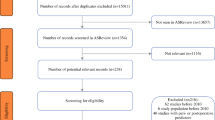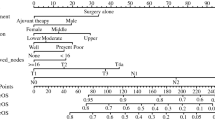Abstract
The ability to predict both short-term and long-term outcome after esophagectomy for cancer is invaluable. It helps us to select the appropriate patients for esophagectomy, to modify surgical procedures or perioperative care to lessen the chance of adverse events, and to decide if neoadjuvant or adjuvant therapies are of value. Predictors of morbidity and mortality after esophagectomy can include many individual factors or their combinations in the form of mathematical scores. Long-term prognosis depends to a large extent on disease stage, but the surgeon can play a major role as well, by minimizing postoperative complications and by performing a R0 resection with extended lymphadenectomy. The accuracy of prediction is improving as technology advances and understanding of the disease becomes more thorough. Information gained should be used for better individualized patient care.
Similar content being viewed by others
References
Law S, Wong KH, Kwok KF, Chu KM, Wong J. Predictive factors for postoperative pulmonary complications and mortality after esophagectomy for cancer. Ann Surg 2004;240:791–800.
Bartels H, Stein HJ, Siewert JR. Preoperative risk analysis and postoperative mortality of oesophagectomy for resectable oesophageal cancer. Br J Surg 1998;85:840–844.
Fekete F, Belghiti J. Nutrition factors and oesophageal resection. In: Jamieson GG, editor. Surgery of the oesophagus. Edinburgh: Churchill Livingstone; 1988. p. 110–124.
Law SY, Fok M, Wong J. Risk analysis in resection of squamous cell carcinoma of the esophagus. World J Surg 1994;18:339–346.
Sanz L, Ovejero VJ, Gonzalez JJ, Laso CA, Azcano E, Navarrete F, Martinez E. Mortality risk scales in esophagectomy for cancer: their usefulness in preoperative patient selection. Hepatogastroenterology 2006;53:869–873.
Bollschweiler E, Schroder W, Holscher AH, Siewert JR. Preoperative risk analysis in patients with adenocarcinoma or squamous cell carcinoma of the oesophagus. Br J Surg 2000;87:1106–1110.
Lagarde SM, Maris AK, de Castro SM, Busch OR, Obertop H, van Lanschot JJ. Evaluation of O-POSSUM in predicting in-hospital mortality after resection for oesophageal cancer. Br J Surg 2007;94:1521–1526.
Lagarde SM, Reitsma JB, Maris AK, Berge Henegouwen MI, Busch OR, Obertop H, et al. Preoperative prediction of the occurrence and severity of complications after esophagectomy for cancer with use of a nomogram. Ann Thorac Surg 2008;85:1938–1945.
Lai F, Kwan TL, Yuen WC, Wai A, Siu YC, Shung E. Evaluation of various POSSUM models for predicting mortality in patients undergoing elective oesophagectomy for carcinoma. Br J Surg 2007;94:1172–1178.
Lerut T. The surgeon as a prognostic factor. Ann Surg 2000;232:729–732.
Birkmeyer JD, Stukel TA, Siewers AE, Goodney PP, Wennberg DE, Lucas FL. Surgeon volume and operative mortality in the United States. N Engl J Med 2003;349:2117–2127.
Birkmeyer JD, Sun Y, Wong SL, Stukel TA. Hospital volume and late survival after cancer surgery. Ann Surg 2007;245:777–783.
Ferri LE, Law S, Wong KH, Kwok KF, Wong J. The influence of technical complications on postoperative outcome and survival after esophagectomy. Ann Surg Oncol 2006;13(4):557–564.
Rizk NP, Bach PB, Schrag D, Bains MS, Turnbull AD, Karpeh M, Brennan MF, Rusch VW. The impact of complications on outcomes after resection for esophageal and gastroesophageal junction carcinoma. J Am Coll Surg 2004;198:42–50.
Lagarde SM, de Boer JD, ten Kate FJ, Busch OR, Obertop H, van Lanschot JJ. Postoperative complications after esophagectomy for adenocarcinoma of the esophagus are related to timing of death due to recurrence. Ann Surg 2008;247:71–76.
Natsugoe S, Yoshinaka H, Shimada M, Sakamoto F, Morinaga T, Nakano S, et al. Number of lymph node metastases determined by presurgical ultrasound and endoscopic ultrasound is related to prognosis in patients with esophageal carcinoma. Ann Surg 2001;234:613–618.
van Westreenen HL, Westerterp M, Bossuyt PM, Pruim J, Sloof GW, van Lanschot JJ, et al. Systematic review of the staging performance of 18F-fluorodeoxyglucose positron emission tomography in esophageal cancer. J Clin Oncol 2004;22:3805–3812.
Sobin LH, Wittekind C, International Union Against Cancer (UICC). TNM classification of malignant tumours. New York: Wiley-Liss; 1997.
Akiyama H, Tsurumaru M, Udagawa H, Kajiyama Y. Radical lymph node dissection for cancer of the thoracic esophagus. Ann Surg 1994;220:364–372.
Udagawa H, Akiyama H. Surgical treatment of esophageal cancer: Tokyo experience of the three-field technique. Dis Esophagus 2001;14:110–114.
Altorki N, Kent M, Ferrara C, Port J. Three-field lymph node dissection for squamous cell and adenocarcinoma of the esophagus. Ann Surg 2002;236:177–183.
Lerut T, Nafteux P, Moons J, Coosemans W, Decker G, De Leyn P, et al. Three-field lymphadenectomy for carcinoma of the esophagus and gastroesophageal junction in 174 R0 resections: impact on staging, disease-free survival, and outcome: a plea for adaptation of TNM classification in upper-half esophageal carcinoma. Ann Surg 2004;240:962–972.
Tong DK, Kwong DL, Law S, Wong KH, Wong J. Cervical nodal metastasis from intrathoracic esophageal squamous cell carcinoma is not necessarily an incurable disease. J Gastrointest Surg 2008;12:1638–1645.
Lagarde SM, Reitsma JB, de Castro SM, ten Kate FJ, Busch OR, van Lanschot JJ. Prognostic nomogram for patients undergoing oesophagectomy for adenocarcinoma of the oesophagus or gastrooesophageal junction. Br J Surg 2007;94:1361–1368.
Peyre CG, Hagen JA, DeMeester SR, van Lanschot JJ, Holscher A, Law S, et al. Predicting systemic disease in patients with esophageal cancer after esophagectomy: a multinational study on the significance of the number of involved lymph nodes. Ann Surg 2008;248:979–985.
Peyre CG, Hagen JA, DeMeester SR, Altorki NK, Ancona E, Griffin SM, et al. The number of lymph nodes removed predicts survival in esophageal cancer: an international study on the impact of extent of surgical resection. Ann Surg 2008;248:549–556.
Japan Esophageal Society. Japanese classification of esophageal cancer, tenth edition: parts II and III. Esophagus 2009;6:71–94.
Rice TW, Rusch VW, Apperson-Hansen C, Allen MS, Chen LQ, Hunter JG, et al. Worldwide esophageal cancer collaboration. Dis Esophagus 2009;22:1–8.
American Joint Committee on Cancer. Esophagus. AJCC cancer staging manual. New York: Springer; 2009.
Altorki NK, Zhou XK, Stiles B, Port JL, Paul S, Lee PC, Mazumdar M. Total number of resected lymph nodes predicts survival in esophageal cancer. Ann Surg 2008;248:221–226.
Greenstein AJ, Litle VR, Swanson SJ, Divino CM, Packer S, Wisnivesky JP. Effect of the number of lymph nodes sampled on postoperative survival of lymph node-negative esophageal cancer. Cancer (Phila) 2008;112:1239–1246.
Schwarz RE, Smith DD. Clinical impact of lymphadenectomy extent in resectable esophageal cancer. J Gastrointest Surg 2007;11:1384–1393.
Rizk NP, Ishwaran H, Rice TW, Chen LQ, Schipper P, Kesler KA, et al. Optimum lymphadenectomy for esophageal cancer. Ann Surg 2009;128:284–295.
Omloo JM, Lagarde SM, Hulscher JB, Reitsma JB, Fockens P, van Dekken H, et al. Extended transthoracic resection compared with limited transhiatal resection for adenocarcinoma of the mid/distal esophagus: five-year survival of a randomized clinical trial. Ann Surg 2007;246:992–1000.
Kato H, Watanabe H, Tachmimori Y, Iizuka T. Evaluation of neck lymph node dissection for thoracic esophageal carcinoma. Ann Thorac Surg 1991;51:931–935.
Nishihira T, Hirayama K, Mori S. A prospective randomized trial of extended cervical and superior mediastinal lymphadenectomy for carcinoma of the thoracic esophagus. Am J Surg 1998;175:47–51.
Rizk NP, Venkatraman E, Bains MS, Park B, Flores R, Tang L, et al. American Joint Committee on Cancer staging system does not accurately predict survival in patients receiving multimodality therapy for esophageal adenocarcinoma. J Clin Oncol 2007;25:507–512.
Law S, Kwong DL, Wong KH, Kwok KF, Wong J. The effects of neoadjuvant chemoradiation on pTNM staging and its prognostic significance in esophageal cancer. J Gastrointest Surg 2006;10:1301–1311.
Mandard A-M, Dalibard F, Mandard J-C, Marnay J, Henry-Amar M, Petiot J-F, et al. Pathologic assessment of tumor regression after preoperative chemoradiotherapy of esophageal carcinoma. Cancer (Phila) 1994;73:2680–2686.
Swisher SG, Hofstetter W, Wu TT, Correa AM, Ajani JA, Komaki RR, et al. Proposed revision of the esophageal cancer staging system to accommodate pathologic response (pP) following preoperative chemoradiation (CRT). Ann Surg 2005;241:810–817.
Schneider PM, Baldus SE, Metzger R, Kocher M, Bongartz R, Bollschweiler E, et al. Histomorphologic tumor regression and lymph node metastases determine prognosis following neoadjuvant radiochemotherapy for esophageal cancer: implications for response classification. Ann Surg 2005;242:684–692.
Lagarde SM, ten Kate FJ, Richel DJ, Offerhaus GJ, van Lanschot JJ. Molecular prognostic factors in adenocarcinoma of the esophagus and gastroesophageal junction. Ann Surg Oncol 2007;14:977–991.
Author information
Authors and Affiliations
Corresponding author
Additional information
Based on a presentation delivered at the 63rd annual meeting of the Japan Esophageal Society, June 25–26, 2009, Yokohama, Japan
Rights and permissions
About this article
Cite this article
Law, S. Prognostication for patients with esophageal cancer. Esophagus 6, 215–219 (2009). https://doi.org/10.1007/s10388-009-0211-2
Received:
Published:
Issue Date:
DOI: https://doi.org/10.1007/s10388-009-0211-2




